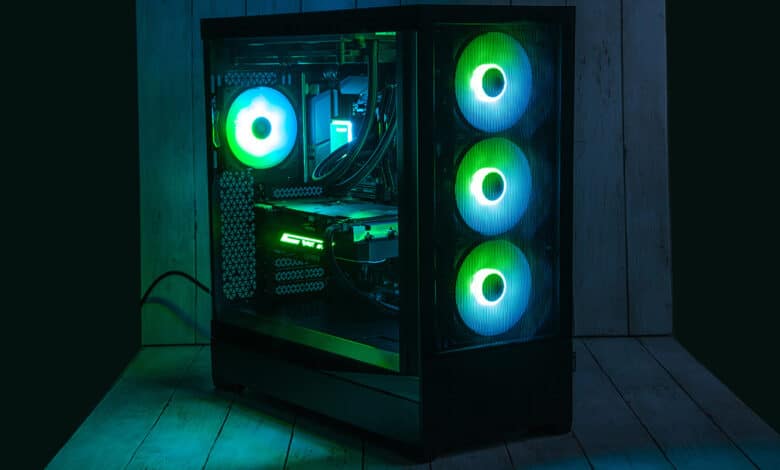
The Swedish brand Fractal Design has been known for high-quality computer components for quite some time and especially the cases enjoy great popularity. The Define series, the Meshify models, the Focus-G as a very good model in the entry-level range and most recently the Torrent models have ascended the airflow throne. My personal main system sits in a somewhat older case from a now discontinued model series of Fractal Design, the Arc XL, because this has apart from its not quite modern design, in addition to a high component flexibility and a good airflow, a feature that you have to do without in many newer cases: 5.25 “slots. Many only think of optical drives, which are used less and less, but there are many more components that can be installed here, such as card readers, fan controllers, removable drives and more. Fractal Design is now back with the new POP series, which offers a modern design in an inexpensive frame, is supposed to have a good airflow and last but not least offers two 5.25” slots. To test the implementation, Fractal Design has provided us with a corresponding case: A Fractal Design Pop XL Air.
In total, the Pop series comes in three sizes – apart from the normal size for ATX mainboards and smaller, there is the XL version tested here, which supports boards up to E-ATX, and the mini version for mATX and mini-ITX boards. Each size comes in both a Silent and Air variant. The Silent version is good for quiet systems that are as less power hungry as possible. The Airflow version, which is the one under review here, is for high-performance gaming computers and workstations.
Fractal Design Pop XL Air Specifications
| Dimensions (L x W x H) | 522 x 230 x 520 mm |
| Fan | 4x Fractal Design Aspect 12 RGB (120 mm) |
| 5.25″ slots | 2x, 1x of which with factory drawer |
| 3.5″-brackets | 3x |
| 2.5″-brackets | 2x dedicated, 3x in 3.5″ mounts |
| Front I/O | 2x USB 3.0, headphones, microphone, power, RGB switch |
| RGB | Switchable integrated, hardware controlled |
| Side window | Tempered Glass |
| Radiator support | Front: up to 360 mm, top: up to 280 mm, rear: up to 140 mm |
| Filter | Top (magnetic), power supply (slide-in) |
| Maximum graphics card length | 455 mm (less with front radiator according to its thickness) |
| Maximum air cooler height | 185 mm |
| Price | MRSP 114,99€ (currently: € 123.98 * |

Packaging and scope of delivery
The packaging of the Fractal Design Pop XL Air is quite typically a brown cardboard box and the case inside is tucked away in a plastic sheet and is protected by two generously sized Styrofoam brackets. Besides the case, the necessary accessories can be found inside the case in a bag: Individually packed screws for the motherboard, the power supply, 2.5″ drives and 5.25″ components as well as for 3.5″ hard drives, otherwise there are a few cable ties and rubber parts for vibration reduction of the 3.5″ hard drives in their holders, plus a manual.
Design, construction and finish
Almost every manufacturer now has a case with a mesh front and power supply cover that also hides the drives. What stands out about Fractal Design’s Pop models is the namesake color scheme – and, of course, the integration of 5.25″ bays, which most competing models do without. Where these are located? They have also migrated to the bottom of the PSU cover… The regular size of the case comes in different colors and with three fans. The XL version of the Fractal Design Pop tested here is currently only available in black and comes with a total of four 120 mm RGB fans – three in the front, one in the back. In many other modern cases, the bottom fan reaches the area of the PSU cover, which is of course not possible here due to the 5.25″ slots. Thus, the regular version does without one of the three usual fans and the case is simply higher in the XL variant tested here. To reach the 5.25″ slots, you pull the front below the mesh grille on a fabric flap – pop, off. Two slots are available, one of which is factory loaded with a 5.25″ drawer that can be used to store USB sticks or cables, for example.
There are three holders for 3.5″ hard drives, which can also be used for 2.5″ drives and even for one 2.5″ and one 3.5″ drive at the same time. From the factory, two of these mounts are located behind the 5.25″ drives and one further up in the cable management area. As always, such mounts can also be found for purchase as individual parts to add on. There is also a bracket for two 2.5″ drives, which can be found behind the motherboard tray at the factory, but can also be relocated to the interior if needed. Alternatively, you can also buy another such bracket for two 2.5″ drives as a supplement.
On the subject of expansion, we also come to the case interfaces: These sit on top of the case and offer two USB 3.0 ports, separate jacks for microphone and headphones, a switch for RGB control, and a power switch. A spot for a USB-C port is prepared, but not built in – you can buy a corresponding expansion kit if needed. Yes, it keeps the price a bit lower, but it’s still a bit disconcerting to not be able to use all the ports written on.
There is little to report on the interior. The standoffs are pre-mounted for an ATX-sized motherboard, with the center pin facing up for optimal alignment, making motherboard mounting very convenient. The expansion slots are completely closed by screwed covers, which looks very high quality. The screws of the expansion slots are thumbscrews, which in principle can be handled without tools, but are practically so tight in their factory state that I could only loosen them with a screwdriver. Since there are no bars between the expansion slots, the case is suitable for a vertical GPU mount, which is of course not included as standard.
The build quality of the Fractal Design Pop XL Air is very good. There are no sharp edges at all; the material and its coating look very high-quality. The filter at the top is held in place with a magnetic strip, as has become common, but it is noticeable that the magnetic strips are particularly thick here, which provides more room for the screw heads than many competing products. The bottom filter for the PSU is easy to pull out backwards for cleaning, so it’s also quite easy to get it back into position without having to tilt the case. The front is neatly air-permeable and also has some texture, which is much more subtle than Fractal Design’s Meshify series, for example.
The fans of the Fractal Design Pop XL Air are difficult to classify in terms of quality. On the one hand, it is noticeable that there is no unlimited budget available for factory fans, for example, rubberized contact surfaces are omitted. On the other hand, the fan blades look very neatly finished and the case of the fans looks quite robust – and they have RGB lighting. The fans themselves do not have PWM control, but 3-pin connectors that have to be regulated by voltage, but they are equipped with a splitter through which you can connect them in series. The same goes for the standardized, i.e. non-proprietary, ARGB connectors – here the fans each have an input as well as an output, which simplifies cable management and reduces necessary slots. The ARGB connectors also look very high quality and sit tighter than those from many other manufacturers. Ergo, it must be said that the fans offer some cool features, but still don’t exactly belong to the premium class.
The Fractal Design Pop XL Air has three of the 120mm fans installed in the front. In principle, you can swap these for two 140 mm fans, but nothing is gained by doing so. On the one hand, one less fan is a loss, on the other hand, the openings in the front are optimally aligned for 120 mm fans and larger fans would blow against sheet metal at the edge. The situation is different with the fan in the back – you could easily replace it with a 140 mm fan.
One decision on the Fractal Design Pop XL Air that is only partially understandable is the large area on the top, which is closed to the front. Thus, you are limited to radiators up to a size of 280 mm on the top, should you go for water cooling. However, it also prevents fresh air from leaving the case too early when using positive pressure air cooling. The side panel is made of glass and is a bit thinner than some competing cases, but again, the workmanship looks solid. The front panel, which you have to remove to access the front fans or the 5.25″ cage, is well made, but fits very tightly, so you need a lot of force the first time you remove it – I was worried about breaking something here, but in the end it worked without damage. With later removals it goes a little easier.
Installation and component flexibility
Installation from the motherboard is a boon in the Fractal Design Pop XL Air due to the center spacer. This raised spacer virtually snaps the motherboard into place, making it easier to screw the motherboard to the other spacers – without any slippage. As far as cooling is concerned, you can rely on air cooling, where the height is sufficient for all common air coolers, as well as water cooling, where you can install a radiator up to 360 mm in the front and a radiator up to 280 mm on top. Radiators can also exceed the usual thickness of AIO models – both the top and the front have a decent amount of space for this. Of course, a radiator up to 140 mm can be installed in the back instead of a fan. Otherwise, the factory-installed fan can be adjusted in height at the back to avoid getting in the way of a radiator or, in the case of air cooling, to be optimally aligned with the heat sink.
On the subject of drive mounting: One of the two lower 3.5″ hard drive mounts can also be moved upwards if you need the space for an actually installed 5.25″ drive. With slim 5.25″ components, such as fan controllers, you can leave the hard drive bracket behind it in place, with optical drives you have to remove the bracket behind it or you can just move it. Furthermore, there is another bracket for up to two 2.5″ drives on the back of the Fractal Design Pop XL Air. This mount can also be moved inside to the PSU cover if needed, which improves its ventilation and can accentuate visually appealing drives.
The bottom cover on the front of the case hides the 5.25″ drives from view, so you can easily hide a DVD drive, for example, and use it occasionally when needed. In order to install a 5.25″ drive securely, it has to be screwed in on both sides. On one side you can quickly get to the screw holes, but to be able to screw in the screws on the other side it gets a bit more complicated. For this, the complete front has to be removed with a hearty jerk, then the 5.25″ cage is unscrewed with four screws on the front. Then the inserted components can be secured with two screws per side and then the cage including drives can be reinstalled and screwed tight. Last but not least, the front is clicked back into place.
Cable Management
The back of the Fractal Design Pop XL Air basically has a pretty decent amount of space for cables, and the view from the front is largely opaque, though the openings for the cables are quite large and don’t have rubber lips, so you can see well to the back there. Cables should therefore be tied to the abundantly available brackets in the best possible way. It quickly gets a bit tighter in the front area with placed hard drives, but you can place some cables around the hard drive holders. The two large Velcro cable holders, which can hold a larger amount of cables including the 24-pin power connector, are very convenient. I would have liked to see more of these in the case.
Due to the size of the case, it is quite easy to spread the cables everywhere in the back and closing it was not a big problem. It’s also handy that you can chain the factory fans together to be able to connect them together to a header if you’re using a motherboard that isn’t abundantly populated with headers. So are the RGB connectors on the fans, which can be connected together to the header on the front panel using the splitter feature.
As for the front panel cables, the Fractal Design Pop XL Air is sparse: one connector for the power button, one SATA connector for powering the RGB controller, one USB 3 cable, and one cable for the audio connectors. Compared to other cases, the ports have been slimmed down a bit. USB 2.0 is no longer offered on the front panel, which eliminates a corresponding cable; there is no HDD LED and thus no cable to connect it; the power LED is controlled by the RGB controller, which is why there is no cable for it either, and a reset switch and its cable are also omitted. Thus, the Fractal Design Pop XL is very clear and easy to wire and you don’t have to struggle with the correct polarity of the front panel LEDs on the corresponding headers. This makes wiring easier, especially for beginners.
Due to the size of the case, there is plenty of room for remaining cables between the power supply and the hard drive mounts or the 5.25″ drives. In summary, the cable management was really very satisfying. The Velcro cable ties are so convenient to use that I would have liked to see more of them than just the two placed in the middle.
Case usage
The 5.25″ drives sit at the very bottom of the Fractal Design Pop XL Air, making them easily accessible when the case is on a desk. If it is below the desk for space reasons, you have to bend over quite a bit. Ergo, it’s really more for modern desktop use, where the look also comes into its own better with the RGB fans.
Speaking of RGB fans, when you connect the fans to the integrated RGB controller, you can control the lighting on the front panel button, which completely replaces the usual reset switch. Even the power switch is RGB illuminated and matches the color scheme of the fans. A long press on the RGB button selects the mode – there’s silent continuous lighting, pulsing, spinning, and complete lighting shutdown here. A short press on the button selects the colors. To avoid having to switch through the colors forever, there is a selection of well-harmonizing dual colors, a rainbow function and a few fixed colors including simple white. However, not all colors can be found individually and there is no software control when using the integrated controller.
Back to the 5.25″ slots: These are accessed by removing a small front cover, which is held in place by magnets. From the factory, there is a small drawer in here, which can be used for storing USB sticks and memory cards, for example. If you install 5.25″ devices with potentiometers, such as fan controllers with knobs, you won’t be able to close the cover. For optical drives or card readers without cards inserted, the cover can be closed again at any time, maintaining the clean look. This cover has no retainer whatsoever – when you pull the tab to remove it, you have the whole cover in your hand.
You could also use the case completely without this cover, but then the magnets are visible on the left and right. The front area of the case on the top side doesn’t have a fan grill, but is solid. This space is well suited for placing additional devices, such as an audio interface or a SATA docking station. For using a 360mm radiator, a larger fan opening would be handy; for using an air cooler, it prevents misplacement of a fan in the front, which would send the fresh, cool air from the front right out of the case before it could arrive at the air cooler.
Performance and Volume
One concern I personally have with the Fractal Design Pop XL Air is the temperature of the hard drives. In previous cases, it was common for the hard drives to sit behind the front fan in order to sit in the airflow with the best possible cooling, as their longevity definitely has to do with temperature. Even in many modern cases, the hard drives sit in their cages in the PSU cover behind fans. In my old workstation case, the Fractal Design Arc XL, I reached a temperature of 28°C at 24°C room temperature for the reading hard drive, a Western Digital Blue, after a quarter of an hour of copying data. With the writing hard disk, a Toshiba Enterprise, the temperature climbed up to 30°C. The front fans were driven with 7V here. The same test in the Fractal Design Pop XL Air leads to a – as expected – warmer result. During the same copy test, the reading hard disk reached a temperature of 32°C, the writing one even 37°C. This time at a room temperature of 25°C. All in all, the temperatures are noticeably higher, but realistically, they are still healthy temperatures for hard disks. In order not to shorten the life span of hard disks, they shouldn’t be operated above 40°C for a long time if possible.
Apart from the hard drives, the cooling performance is of course of interest as far as the processor and the graphics card are concerned. To be fair, my old Fractal Design Arc XL is modified with dust filters removed and it runs Noctua NF-A14 and NF-A12x25, which at 50% speed are about the same as the maximum speed of the fans in the Fractal Design Pop XP Air. In addition, the Arc XL does not have a PSU cover, but offers a fan space at the bottom that directly supplies fresh air to the graphics card.
The test system:
AMD Ryzen 9 5950X with an all-core overclock to 140W power consumption, air-cooled with a DeepCool AK620.
The graphics card used is a GeForce GTX 1070 with an overclock and 160W power consumption.
Testing method:
A continuous run is started in Cinebench and the processor’s average temperature is measured for one minute after eight minutes of warm-up time. In the 3DMark Time Spy stress test, the graphics card is loaded for 10 minutes and then the temperature is read, as well as the automatically regulated fan speed. A higher speed means a higher noise level.
To compensate for the varying room temperature, this is also read at the time of the measurement. Finally, the delta is displayed, i.e. the difference between room temperature and CPU or graphics card temperature.
The test is performed with the Fractal Design Pop XL Air with factory-equipped fans, for comparison the Fractal Design Arc XL with Noctua fans and finally the Pop XL Air with the Noctua fans from the old case. This isn’t a recommended tactic, as those who invest in this case are of course paying for the installed RGB fans, which operate quietly and are definitely more than just nice to look at. Nevertheless, I wanted to perform the test to transfer the performance advantage of the fans from the old case to the Fractal Design Pop XL Air for fairness reasons and thus get a better comparability of the airflow offered. The fans now used cost more together than the complete case.
| Fractal Design Arc XL + Noctua fan | Fractal Design Pop XL Air | Fractal Design Pop XL Air + Noctua fan | |
| 50% fan performance of all fans (incl. CPU cooler | |||
| Cinebench | CPU Delta: 54.7°C | CPU delta: 54.7°C | not tested |
| Time Spy Stress Test | GPU delta: 37°C at 1800 RPM | GPU delta: 38°C at 1840 RPM | not tested |
| 100% fan performance of all fans (incl. CPU cooler | |||
| Cinebench | CPU Delta: 47.5°C | CPU delta: 46.8°C | CPU delta: 45.1°C |
| Time Spy Stress Test | GPU delta: 35°C at 1720 RPM | GPU delta: 37°C at 1800 RPM | GPU delta: 36°C at 1770 RPM |
Despite the fan speed disadvantage, the Fractal Design Pop XL Air already offers lower temperatures on the processor at 100% performance and noticeably lower noise. It is noticeable on the graphics card that there is no Intake fan at the bottom blowing directly on it, which is why it gets slightly warmer than on the old case. The hard drives, as already mentioned, are not exposed to direct airflow and are therefore warmer than on cases of the classic design, but this should only be relevant for high-speed hard drives, which have largely been replaced by SSDs these days.
Overall, however, the case with its factory fans stands out with a great smoothness – it sounds very unobtrusive, unagitated and quiet. At 100% fan power, it is clearly noticeable, but is still quiet enough that the Fractal Design Pop XL Air’s case fans can quickly be drowned out by the graphics card or CPU cooler.
Fractal Design Pop XL Air review conclusion
The Fractal Design Pop XL Air is a modern airflow case with classic features. It can fit some drives that are hard to find space for in most modern cases. So you can place some SATA drives from 2.5″ storage media to 3.5″ hard drives to 5.25″ BluRay drive. Those who do not want to do without these interfaces, but still want a quiet, visually modern case, will find what they are looking for in Fractal Design’s Pop series. The combination of the relatively very good price, an expandability of 5.25″ components that is not trimmed in contrast to other modern cases, and the quiet and visually appealing fans make the Fractal Design Pop XL Air one of this year’s case highlights for me.
Fractal Design Pop XL Air
Workmanship
Structure
Features
Dampening
Cooling
Value for money
95/100
The Fractal Design Pop XL Air offers a very good price, clean workmanship and rich fan equipment with the 5.25" slots, which is an absolutely unique selling point among modern airflow cases.










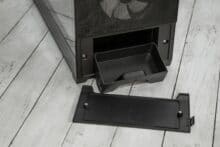
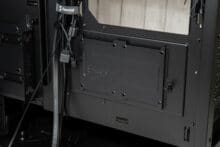



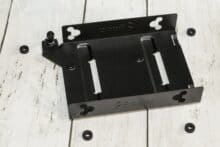

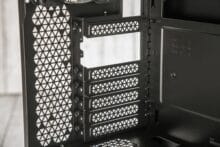








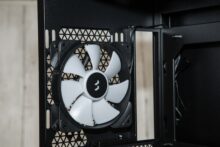
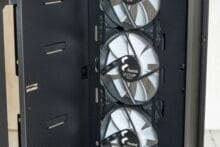





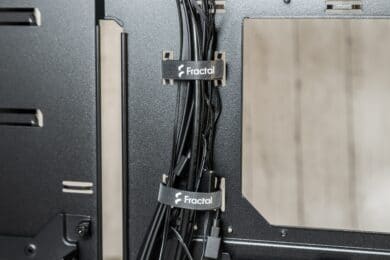
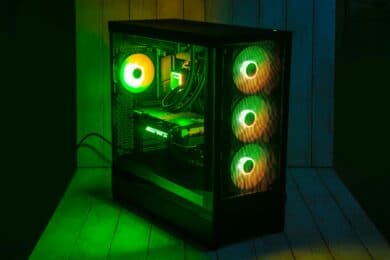


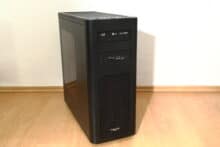



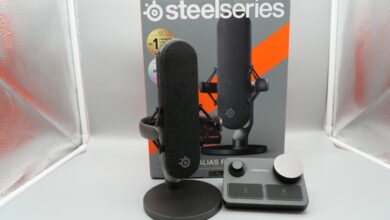
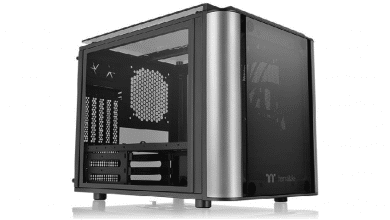

No replies yet
Neue Antworten laden...
Gehört zum Inventar
Beteilige dich an der Diskussion in der Basic Tutorials Community →